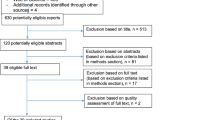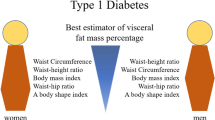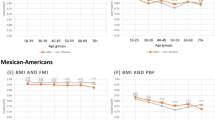Abstract
Background/objectives
Few longitudinal studies have examined the association between diabetes risk and body composition in Asians. The aim of this prospective cohort study was to determine the role of body composition, estimated by whole-body dual-energy X-ray absorptiometry, in the development of diabetes and to examine the impact of body composition on diabetes risk in normal weight (body mass index (BMI) <23 kg/m2) and overweight/obese groups (≥23 kg/m2).
Subjects/methods
We measured the body composition for 1532 diabetes-free subjects (463 men and 1069 women), aged 48–79 years, at the baseline examination period from 1994–96 and followed-up to detect new cases of diabetes over the next 15 years (median 13.4 years).
Results
After being adjusted for BMI and other potential confounding factors, body fat distribution was associated with diabetes risk. Percentage of trunk fat was positively associated with the development of diabetes (hazards ratio (HR) per 1 SD (95% confidential interval (CI)), 1.58 (1.10–2.28) in men, and 1.34 (0.99–1.83) in women), and percentage of leg fat was negatively associated with the development of diabetes (HR per 1 SD (95% CI), 0.68 (0.50–0.91) in men and 0.68 (0.55–0.85) in women). The estimated HRs of % trunk and leg fat on the development of diabetes differed little between normal weight and overweight/obese subjects. Appendicular lean mass was also negatively associated with diabetes risk only in normal weight men.
Conclusions
Opposite associations of trunk fat and leg fat with diabetes risk were observed. Assessment of body composition might help in the evaluation of diabetes risk.
This is a preview of subscription content, access via your institution
Access options
Subscribe to this journal
Receive 12 print issues and online access
$259.00 per year
only $21.58 per issue
Buy this article
- Purchase on Springer Link
- Instant access to full article PDF
Prices may be subject to local taxes which are calculated during checkout

Similar content being viewed by others
References
Shaw JE, Sicree RA, Zimmet PZ. Global estimates of the prevalence of diabetes for 2010 and 2030. Diabetes Res Clin Pract. 2010;87:4–14.
Chan JC, Malik V, Jia W, Kadowaki T, Yajnik CS, Yoon KH, et al. Diabetes in Asia: epidemiology, risk factors, and pathophysiology. JAMA. 2009;301:2129–40.
Haslam DW, James WP. Obesity. Lancet. 2005;366:1197–209. Review
Huxley R, James WP, Barzi F, Patel JV, Lear SA, Suriyawongpaisal P, et al. Obesity in Asia Collaboration. Ethnic comparisons of the cross-sectional relationships between measures of body size with diabetes and hypertension. Obes Rev. 2008; 9 Suppl 1:53-61.
Yoon KH, Lee JH, Kim JW, Cho JH, Choi YH, Ko SH, et al. Epidemic obesity and type 2 diabetes in Asia. Lancet. 2006;368:1681–8.
He W, Zhang S, Song A, Yang M, Jiao J, Allison DB, et al. Greater abdominal fat accumulation is associated with higher metabolic risk in Chinese than in white people: an ethnicity study. PLoS ONE. 2013;8:e58688.
Kadowaki T, Sekikawa A, Murata K, Maegawa H, Takamiya T, Okamura T, et al. Japanese men have larger areas of visceral adipose tissue than Caucasian men in the same levels of waist circumference in a population-based study. Int J Obes (Lond). 2006;30:1163–5.
Lim U, Ernst T, Buchthal SD, Latch M, Albright CL, Wilkens LR, et al. Asian women have greater abdominal and visceral adiposity than Caucasian women with similar body mass index. Nutr Diabetes. 2011;1:e6.
Hsu WC, Araneta MR, Kanaya AM, Chiang JL, Fujimoto W. BMI cut points to identify at-risk Asian Americans for type 2 diabetes screening. Diabetes Care. 2015;38:150–8.
Yamada M, Wong FL, Fujiwara S, Akahoshi M, Suzuki G. Noncancer disease incidence in atomic bomb survivors, 1958-98. Radiat Res. 2004;161:622–32.
WHO expert consultation. Appropriate body-mass index for Asian populations and its implications for policy and intervention strategies. Lancet. 2004;363:157–63.
Fujiwara S, Kasagi F, Masunari N, Naito K, Suzuki G, Fukunaga M. Fracture prediction from bone mineral density in Japanese men and women. J Bone Miner Res. 2003;18:1547–53.
Laskey MA. Dual-energy X-ray absorptiometry and body composition. Nutrition. 1996;12:45–51.
Tankó LB, Bagger YZ, Alexandersen P, Larsen PJ, Christiansen C. Peripheral adiposity exhibits an independent dominant antiatherogenic effect in elderly women. Circulation. 2003;107:1626–31.
Chobanian AV, Bakris GL, Black HR, Cushman WC, Green LA, Izzo JL,Jr, et al. Seventh report of the Joint National Committee on prevention, detection, evaluation, and treatment of high blood pressure. Hypertension. 2003;42:1206–52.
Teramoto T, Sasaki J, Ishibashi S, Birou S, Daida H, Dohi S, et al. Executive summary of the Japan Atherosclerosis Society (JAS) guidelines for the diagnosis and prevention of atherosclerotic cardiovascular diseases in Japan -2012 version. J Atheroscler Thromb. 2013;20:517–23.
Cullings HM, Fujita S, Funamoto S, Grant EJ, Kerr FD, Preston DL. Dose estimation for atomic bomb survivor studies: its evolution and present status. Radiat Res. 2006;166:219–54.
Seino Y, Nanjo K, Tajima N, Kadowaki T, Kashiwagi A, Araki E, et al. Report of the Committee on the classification and diagnostic criteria of diabetes mellitus. J Diabetes Invest. 2010;1:212–28.
Tatsukawa Y, Misumi M, Yamada M, Masunari N, Oyama H, Nakanishi S, et al. Alterations of body mass index and body composition in atomic bomb survivors. Int J Obes (Lond). 2013;37:1123–8.
Grambsch PM, Therneau TM. Proportional hazards tests and diagnostics based on weighted residuals. Biometrika. 1994;81:515–26.
Cologne JB, Hsu W, Abbott RD, Ohishi W, Grant EJ, Fujiwara S, et al. Proportional hazards regression in epidemiologic follow-up studies: an intuitive consideration of primary time scale. Epidemiology. 2012;23:565–73.
Michels KB, Greenland S, Rosner BA. Does body mass index adequately capture the relation of body composition and body size to health outcomes? Am J Epidemiol. 1998;147:167–72.
Aung K, Lorenzo C, Hinojosa MA, Haffner SM. Risk of developing diabetes and cardiovascular disease in metabolically unhealthy normal-weight and metabolically healthy obese individuals. J Clin Endocrinol Metab. 2014;99:462–8.
Heianza Y, Arase Y, Tsuji H, Fujihara K, Saito K, Hsieh SD, et al. Metabolically healthy obesity, presence or absence of fatty liver, and risk of type 2 diabetes in Japanese individuals: Toranomon hospital health management center study 20 (TOPICS 20). J Clin Endocrinol Metab. 2014;99:2952–60.
Hinnouho GM, Czernichow S, Dugravot A, Nabi H, Brunner EJ, Kivimaki M, et al. Metabolically healthy obesity and the risk of cardiovascular disease and type 2 diabetes: the Whitehall II cohort study. Eur Heart J. 2015;36:551–9.
Primeau V, Coderre L, Karelis AD, Brochu M, Lavoie ME, Messier V, et al. Characterizing the profile of obese patients who are metabolically healthy. Int J Obes (Lond). 2011;35:971–81.
Manolopoulos KN, Karpe F, Frayn KN. Gluteofemoral body fat as a determinant of metabolic health. Int J Obes (Lond). 2010;34:949–59.
Sánchez-López M, Ortega FB, Moya-Martínez P, López-Martínez S, Ortiz-Galeano I, Gómez-Marcos MA, et al. Leg fat might be more protective than arm fat in relation to lipid profile. Eur J Nutr. 2013;52:489–95.
Snijder MB, Visser M, Dekker JM, Goodpaster BH, Harris TB, Kritchevsky SB, et al. Low subcutaneous thigh fat is a risk factor for unfavourable glucose and lipid levels, independently of high abdominal fat. The Health ABC Study. Diabetologia. 2005;48:301–8.
Sakai Y, Ito H, Egami Y, Ohoto N, Hijii C, Yanagawa M, et al. Favourable association of leg fat with cardiovascular risk factors. J Intern Med. 2005;257:194–200.
Wu H, Qi Q, Yu Z, Sun Q, Wang J, Franco OH, et al. Independent and opposite associations of trunk and leg fat depots with adipokines, inflammatory markers, and metabolic syndrome in middle-aged and older Chinese men and women. J Clin Endocrinol Metab. 2010;95:4389–98.
Levine JA, Abboud L, Barry M, Reed JE, Sheedy PF, Jensen MD. Measuring leg muscle and fat mass in humans: comparison of CT and dual-energy X-ray absorptiometry. J Appl Physiol. 2000;88:452–6.
Visser M, Fuerst T, Lang T, Salamone L, Harris TB. Validity of fan-beam dual-energy X-ray absorptiometry for measuring fat-free mass and leg muscle mass. Health, aging, and body composition study--dual-energy X-ray absorptiometry and body composition working group. J Appl Physiol. 1999;87:1513–20.
Atlantis E, Martin SA, Haren MT, Taylor AW, Wittert GA, Members of the Florey Adelaide Male Ageing Study. Inverse associations between muscle mass, strength, and the metabolic syndrome. Metabolism. 2009;58:1013–22.
Schubert CM, Rogers NL, Remsberg KE, Sun SS, Chumlea WC, Demerath EW, et al. Lipids, lipoproteins, lifestyle, adiposity and fat-free mass during middle age: the Fels Longitudinal study. Int J Obes (Lond). 2006;30:251–60.
Kim KS, Park KS, Kim MJ, Kim SK, Cho YW, Park SW Type 2 diabetes is associated with low muscle mass in older adults. Geriatr Gerontol Int. 2014; Suppl 1:115-21.
Visser M, Pahor M, Tylavsky F, Kritchevsky SB, Cauley JA, Newman AB, et al. One- and two-year change in body composition as measured by DXA in a population-based cohort of older men and women. J Appl Physiol. 2003;94:2368–74.
Frayn KN. Adipose tissue as a buffer for daily lipid flux. Diabetologia. 2002;45:1201–10.
Acknowledgements
The RERF, Hiroshima and Nagasaki, Japan is a public interest foundation funded by the Japanese Ministry of Health, Labour and Welfare (MHLW) and the US Department of Energy (DOE). The views of the authors do not necessarily reflect those of the two governments. This publication was supported by RERF Research Protocols RP # 3-89 and # 7-10. This study was also supported by the Japan Society for the Promotion of Science (JSPS) KAKENHI (25860458), and a grant-in-aid from the MHLW of Japan (Comprehensive Research on Cardiovascular and Life-Style Related Diseases: H29-Junkankitou [Seishuu]-Ippan-003). Miriam Bloom (SciWrite Biomedical Writing and Editing Services) provided professional English-language editing.
Author information
Authors and Affiliations
Corresponding author
Ethics declarations
Conflict of interest
The authors declare that they have no conflict of interest.
Electronic supplementary material
Rights and permissions
About this article
Cite this article
Tatsukawa, Y., Misumi, M., Kim, Y.M. et al. Body composition and development of diabetes: a 15-year follow-up study in a Japanese population. Eur J Clin Nutr 72, 374–380 (2018). https://doi.org/10.1038/s41430-017-0077-7
Received:
Revised:
Accepted:
Published:
Issue Date:
DOI: https://doi.org/10.1038/s41430-017-0077-7
This article is cited by
-
Association between segmental body composition and bone mineral density in US adults: results from the NHANES (2011–2018)
BMC Endocrine Disorders (2023)
-
Causal discovery approach with reinforcement learning for risk factors of type II diabetes mellitus
BMC Bioinformatics (2023)
-
A cohort study on the predictive capability of body composition for diabetes mellitus using machine learning
Journal of Diabetes & Metabolic Disorders (2023)
-
Thigh circumference and handgrip strength are significantly associated with all-cause mortality: findings from a study on Japanese community-dwelling persons
European Geriatric Medicine (2021)
-
Fat redistribution and accumulation of visceral adipose tissue predicts type 2 diabetes risk in middle-aged black South African women: a 13-year longitudinal study
Nutrition & Diabetes (2019)



